How to Do Risk Assessment of IT Networks for FDA compliance
With the complexity of today’s IT infrastructure and the applications running on networks there is always a risk that something goes wrong. Consequences can be a significant loss of revenue because of production stops, potential safety or health problems if inaccurate data transfer led to inaccurate reporting of laboratory results with consequent inadequate releases of Read more about How to Do Risk Assessment of IT Networks for FDA compliance[…]
